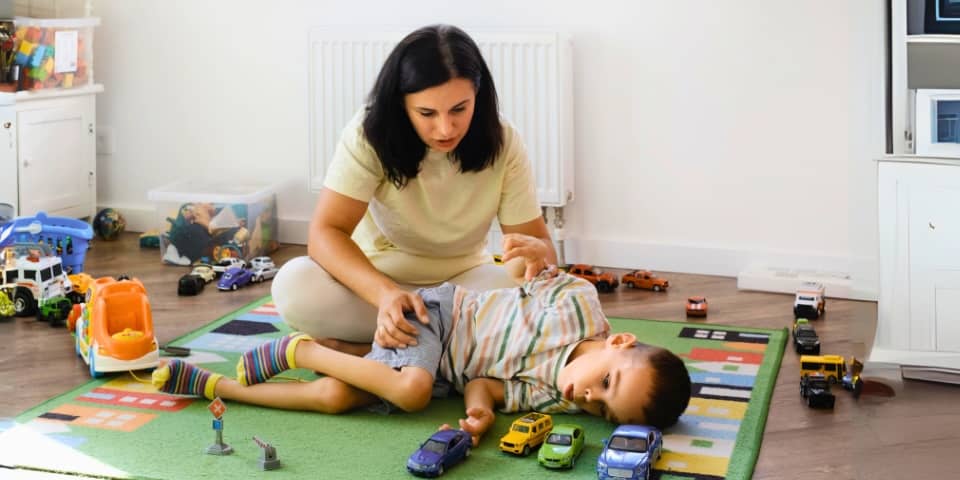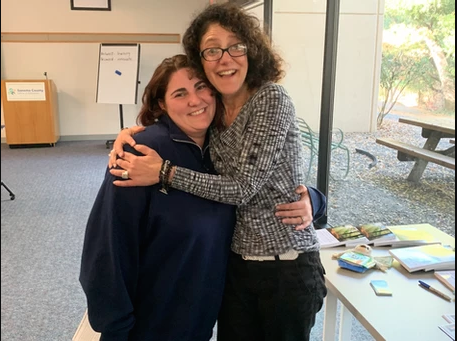Getting Off the Rails Behavior Back on Track
By Carey Gil, LCSW
Meltdowns are scary, for children and for parents! They often spark deep insecurities about whether we are “good enough” parents. Our own history of emotional, physical or verbal aggression can make these moments even more complicated.
Handling incidents of dysregulation is one of the most important ongoing challenges we face as parents. If you’re parenting a child with strong and quick emotional reactions, a history of trauma and/or drug/alcohol exposure (or all of the above!) your need for support and your quest for techniques in these moments is never-ending. While each family and child is unique, these tips will help you to meet those tough moments with confidence, while maintaining connection with your child.
Staying Calm: It Starts With You
Escalating children need to “borrow” their parents’ calm nervous system. After all, you’ve got decades more experience at self-soothing than they do! Meeting anger with anger (“fire with fire”) only escalates responses and decreases parent-child connections. Have some go-to, multisensory techniques for yourself, to keep yourself grounded and able to respond to your child instead of reacting from a place of fear and anger. Try a hand to your chest, a deep exhale, and a “You can cope with this” affirmation, for example. Cold temperatures (drinking water, cold shower, ice pack to the face or neck, holding ice) can help shortcut your nervous system back into a calmer state.
Be A Need Detective:
When behaviors start to escalate, take a step back and ask yourself “What does this child need?” Behaviors always show up for a reason—tantrums over the cookie may be really about control, or an emotional need for comfort food after a tough day, or feeling ignored, or simply hungry. Your response and success at helping your child through their discomfort will vary greatly depending on your assessment of what your child needs.
Put out sparks before they become fires:
Catch and meet needs at a low intensity level. Use a playful tone of voice to redirect, request re-dos of annoying behaviors, and give prompts that help kids know how to get what they need in a pro-social way. Use “positive” language such as “please ask in a calm voice.” Be mindful not to overrespond to the moment, when disproportionate responses can escalate and even cause dysregulated behavior.
Beware of misattribution bias:
Ever been told “stop yelling at me” when you weren’t yelling? There’s a reason! Research shows teens perceive neutral faces as hostile. Overactive “fight or flight” responses exacerbate this misinterpretation in people of all ages. Immediate fear activation heightens all senses, and everything feels louder, scarier and more intense. Parents need to mindfully adjust their tone, cadence and facial expressions accordingly as they intervene with the child. Use a lighter tone, softer eyes and relaxed body language. Make yourself deliberately non-threatening in that moment so that you can help pull your child back into the zone where they’re capable of problem solving with you.
Choose your words carefully:
Information eventually gets into the brain during high emotional moments, but it is slow and it has to fight through the pumping biological and chemical systems first. The more escalated your child gets, the fewer words you should use; lower your tone of voice and slow down your rate of speech. Avoid lectures, complex questions, or a lot of verbal brainstorming. Think simple, structured, clear, quiet and calm.
The Parenting Formula: Regulate-relate-review/reason
Your goals during these tough moments are:
- Keep everyone physically safe
- Maintain emotional connection with the child
- Gain experience with emotional regulation
- Learn new skills which can help everyone manage challenges more successfully next time
Follow the mantra “connection over correction” knowing that your ability to reconnect and calm your child in that moment is paramount. The teachable moments will come later. Follow this parenting “formula” to guide you:
Regulate: Calm through breath, touch (only if helpful; the more agitated the child, the less likely this will work), cold elements (air, water, ice) or weighted blankets—anything that you and your child have developed in advance. Biologically we can’t drink and cry at the same time so a sip of cold water can be the pause needed to reset.
Relate: Emotional reconnection with the child is the ultimate goal. “You’re a good kid having a hard time, and I’m here in this with you” reframes the parent-child duo as teammates and not adversaries. Identify and validate feelings and share your’s factually. Reinforce your love for the child, their worthiness and their right to have emotions without adding “yeah but” or preaching.
Review/Reason: Once everyone is calm and reconnected, briefly review your understanding of what happened and ask for “clues” to help you both understand why it unfolded. Approach from a curious, calm and non-judgemental stance. Check back with the child for understanding. “You really wanted the cookie for breakfast and when I said no, you felt a lot of anger and yelled, and then I yelled too. Is that how it went for you?”
After connecting on what happened, explore preferred future alternatives. “I’d hate for us to have to go through this much stress next time. What do you think we can try instead? How can we meet that need?” Keep it brief, collaborative, and proactive.
REPAIR
Have a habit of “making it right” with each other. Use simple, empathetic, non-judgemental language. Hugs, “band aids”, cleaning up a mess that was made, acknowledging mistakes and apologizing, and showing positive emotional energy can all help rebuild damaged relationships. This goes for parents as well as for kids! Your role modelling here is important.
PRE-EMPTIVE SAFETY PLANNING
Pre-planning and rehearsal is key in managing emotional meltdowns. Develop a safety plan for yourself and for your child BEFORE you need it. Consider the following:
Safe space: Where can the child go to ride out their feelings? It should be comfortable, quiet, and can ideally accommodate a trusting adult also.
- Stock with items from their coping skills plan (e.g. music, weighted blanket, etc)
- Remove safety hazards
- Plan for safe alternative activities and spaces for other kids in the home if you’ll be busy temporarily tending to this child
Support team: Who will support the child? Develop a code word or agreement about how you’ll switch off if you need a break to remain calm. Explain to your child “Dad’s going to sit with you for a while, and I need to go to my room for 10 minutes to cool off so I can be helpful to you. I love you and I’ll be back.” Identify other supports (e.g. a therapist, teacher, family member) who may be able to play a helpful role, and prep them with an action plan describing your child’s coping strategies.
Emergency planning: Have crisis line numbers ready. Train yourself in recognizing the type of mental health crisis which requires psychiatric holds or interventions. Learn how to call 988 for help and to ask for a mental health-trained evaluation team.
Just as with other parenting challenges, managing big behaviors requires understanding and preparation. Anticipating triggers and then following these strategies will give you tools to help meet your children’s needs and get them back on track when you see them going off the rails.
Carey Gil, LCSW has spent over 20 years supporting Bay Area families in their growth and healing. She firmly believes in the human power to triumph and blossom after hardship and trauma because she has borne witness to it hundreds of times. She holds advanced certificates and training in trauma and therapy modalities including: TBRI Practitioner, Certified Family Trauma Professional, Trauma-Focused Cognitive Behavioral Therapy, Dialectical Behavioral Therapy, Emotional Freedom Technique and the Trauma Research Foundation’s Certificate in Traumatic Stress Studies, where she studied under Bessel van der Kolk.
With training and experience working extensively with foster youth, foster/adoptive families, divorce/coparenting and families in crisis, she is a wise and encouraging voice to guide you on your journey. She loves supporting families to bond, repair relationships and grow, and to support individuals in their personal trauma healing. She has developed trainings and coached biological, foster and adoptive families through family court, DFCS, and the Refugee Foster Care program. Her direct work with individual and family trauma recovery has given her a unique lens on how to marry traditional parenting and therapy methods with trauma-informed interventions that actually create stronger relationships and mental health healing.
Carey is a private practice therapist at Lotus Counseling Services in San Jose (https://lotuscounselingca.com). She is also a Lecturer and Faculty Field Liaison at the SJSU Graduate School of Social Work where enjoys sharing her passion with the next generation of helping professionals. Beyond her professional responsibilities, Carey says that her greatest learning is done at home parenting her own children, who have a variety of special emotional and educational needs.









